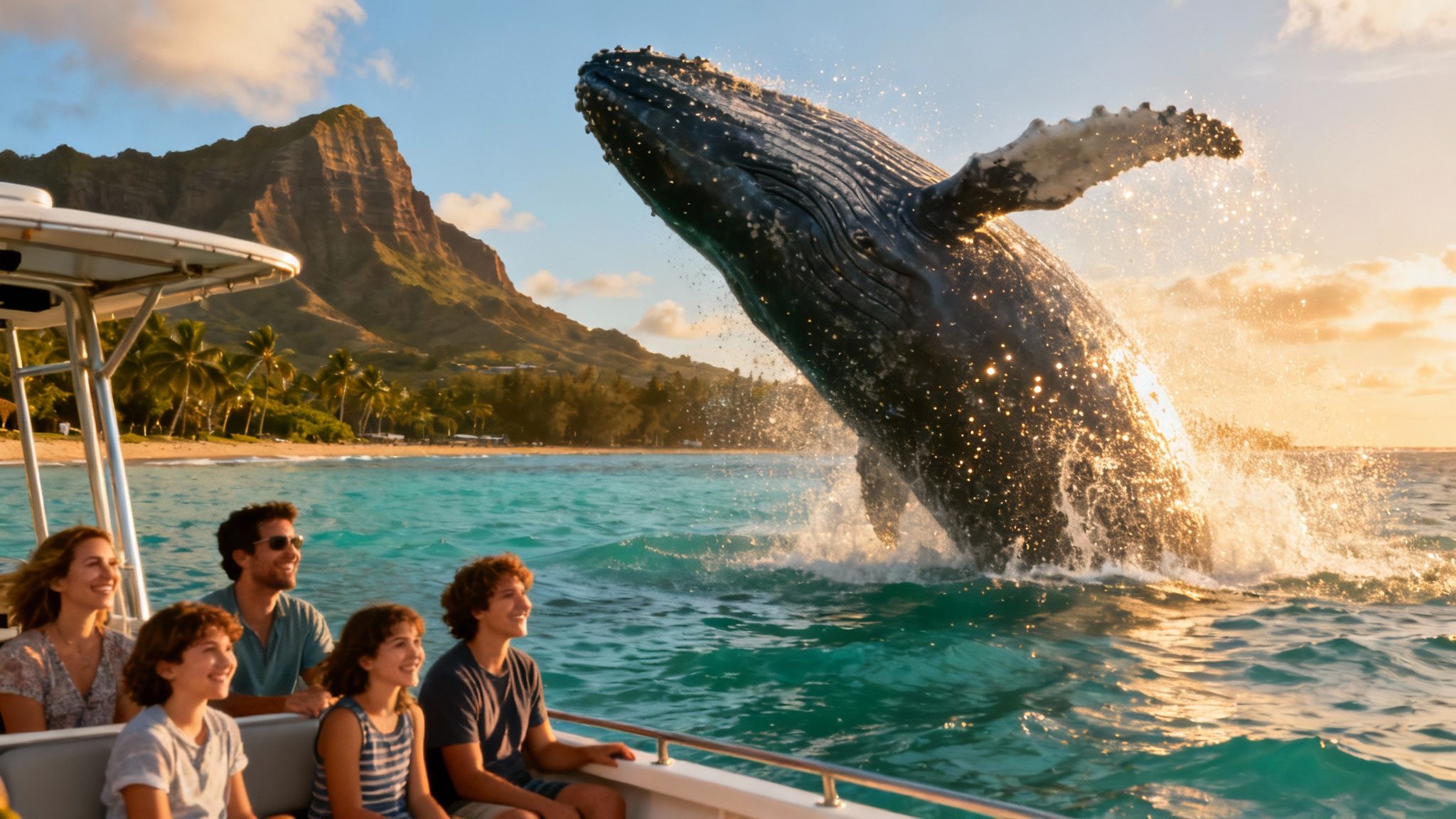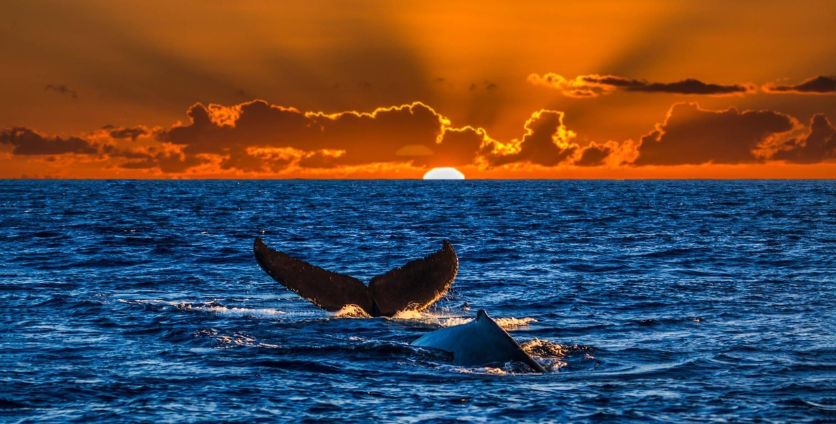Picture this: the turquoise water off Waikiki suddenly explodes as a forty-ton humpback whale launches its entire body into the air. This isn’t a scene from a nature documentary—it’s a real, and surprisingly common, sight when you go whale watching in Honolulu. If you're hoping to experience this for yourself, you've come to the right place. This guide has everything you need to plan a truly unforgettable day on the water.
Your Front-Row Seat to Nature's Greatest Show
Seeing the annual humpback whale migration is, without a doubt, one of Oahu's most incredible natural events. Every winter, these gentle giants travel over 3,000 miles from their chilly feeding grounds in Alaska to the warm, sheltered waters of Hawaii. They come here to breed, give birth, and nurse their newborn calves, turning the ocean off Honolulu into a massive, lively nursery.
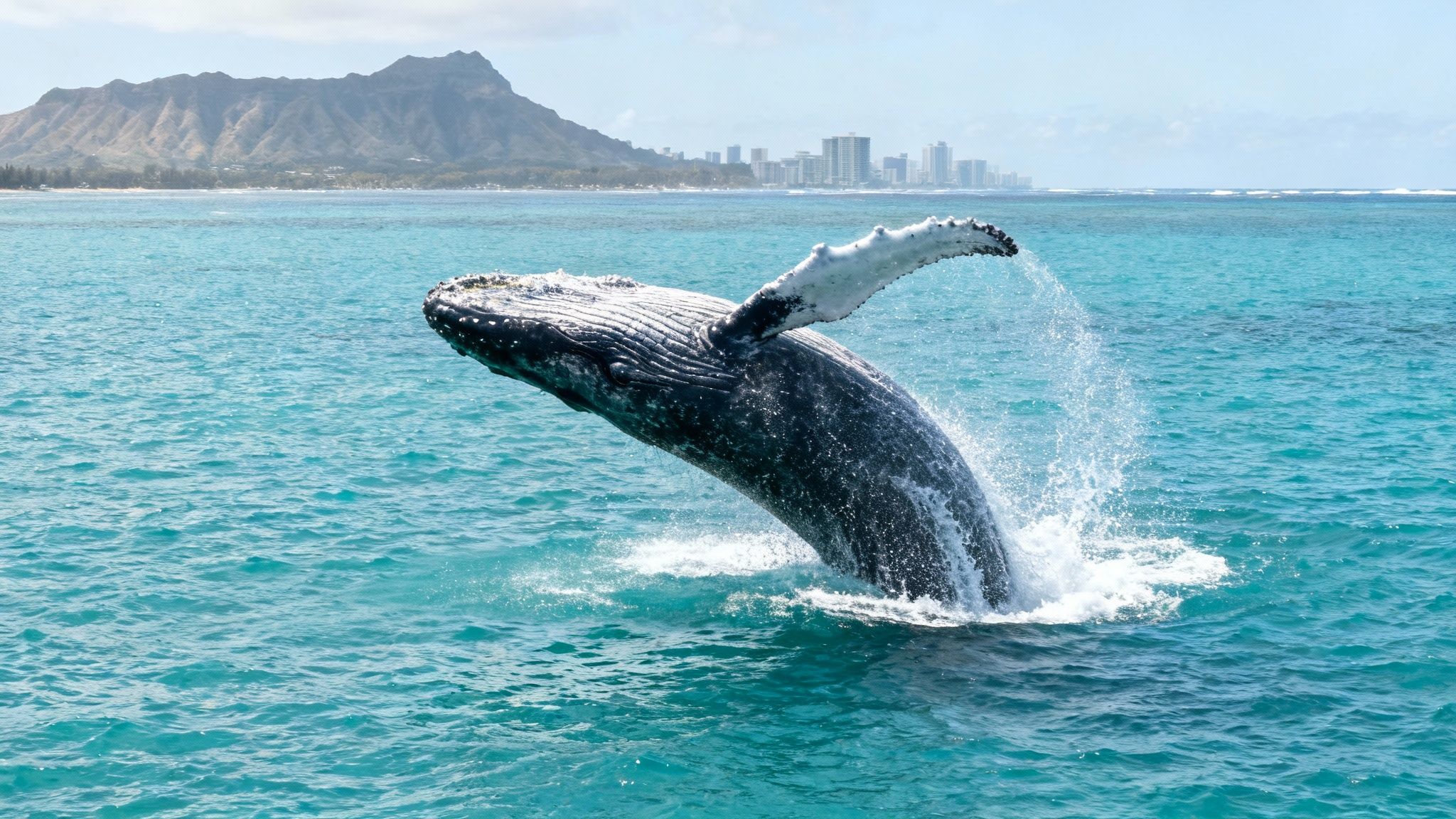
The key to a great trip is going out with an experienced and respectful crew. As the top-rated and most-reviewed snorkel company on Oahu, Living Ocean Tours has built a reputation for creating memorable wildlife encounters that put the animals first. Their expertise really sets the stage for an amazing day.
Why Honolulu is a Whale Watching Hotspot
The waters off Waikiki and the south shore offer the perfect blend of easy access and high whale activity. Unlike more remote spots, our tours leave just minutes from the main hotels, which makes fitting this adventure into your vacation a breeze.
The calm, shallow waters here are a favorite for mother whales and their calves. This preference dramatically increases your chances of having those truly special, up-close sightings that you’ll be talking about for years. It's what makes a whale watching Honolulu tour such a fantastic choice for families and first-timers.
This experience is about so much more than just spotting a whale. It's about feeling the rhythm of the ocean and witnessing one of nature's most epic journeys. From the thunderous crack of a tail slap echoing across the water to the quiet, tender moment a mother nudges her calf to the surface, these are the memories that stick with you.
What a Day on the Water Looks Like
A typical tour runs for a few hours, giving you plenty of time to cruise out to the best viewing spots and patiently wait for the magic to happen. And the trip out is part of the fun—you get stunning views of the Oahu coastline, including Diamond Head and the famous Waikiki skyline.
Here’s what you can generally expect on a tour with a great operator:
- Expert Guides: The crew will share fascinating facts about humpback behavior, their incredible migration, and the local marine life you might see. It’s like having a marine biologist on board.
- Guaranteed Sightings: During peak season, the best tours have such a high success rate that they often guarantee you'll see whales.
- Respectful Viewing: Professional tours know the rules. They strictly follow federal regulations, keeping a safe and respectful distance to make sure the whales are never stressed or disturbed.
Ready to see these magnificent creatures for yourself? You can learn more about what a premier Honolulu whale watching tour offers and book your spot for an adventure you won't soon forget on our whale watching tour page.
Finding the Best Time for Whale Watching
Timing is everything if you want an unforgettable whale watching trip. Every year, thousands of humpback whales make the incredible journey from their chilly feeding grounds in Alaska all the way down to Hawaii's warm, protected waters. They come here to breed, give birth, and nurse their calves, turning Honolulu into one of the best places on the planet to see them in action.
Getting in sync with this natural rhythm is the secret to booking a tour with jaw-dropping sightings. The absolute best time to go is from December through March, when the ocean is alive with activity.
As you plan your dates, it’s worth noting that Living Ocean Tours is the top-rated and most-reviewed snorkel company on Oahu for a reason. We’ve built our reputation on creating respectful, memorable encounters with marine life, and our expertise means you're in for an incredible day on the water.
The Whale Watching Calendar Month by Month
While the whole season is fantastic, the kind of whale behavior you'll see changes a bit from month to month. Think of it like a three-act play—each part of the season has its own unique energy.
-
December: The Arrivals: This is when the first wave of humpbacks starts to show up. It’s a great time to see adult males competing for mates, which leads to some thrilling surface action like powerful tail slaps and breaches as they show off.
-
January & February: The Peak: These two months are the absolute sweet spot. The waters are practically buzzing with whales, including pregnant females arriving to give birth. This is your best shot at seeing newborn calves, or keiki, sticking close to their moms.
-
March: The Grand Finale: As the season starts to wind down, you'll see mothers and their growing calves getting ready for the long trip back north. It’s a wonderful time to witness tender bonding moments and watch the calves practice essential skills like breaching.
Maximizing Your Sighting Opportunities
Honestly, the best time of day often comes down to what you prefer. Whales are active all day long, but morning tours often have calmer seas, which is a big plus if you're worried about getting seasick. Afternoon trips, on the other hand, can offer that beautiful golden light that makes for stunning photos.
No matter which month you pick, the sheer number of whales here is just staggering. On a single day's survey—January 25, 2025—volunteers for the Sanctuary Ocean Count tallied an incredible 399 humpback whale sightings around Oahu alone. That number gives you a real sense of just how dense the population is during peak season.
The key takeaway is this: while January and February are considered the peak, any tour booked between mid-December and the end of March gives you an exceptionally high chance of witnessing these magnificent creatures.
For a deeper dive into what each month holds, check out our detailed guide on the Oahu whale watching season. Planning ahead is always a good idea to make sure you can snag a spot on the perfect tour for your trip.
Understanding Humpback Whale Behaviors
What makes a whale watching tour in Honolulu so electrifying isn't just spotting a distant puff of water on the horizon; it's getting a front-row seat to the incredible behaviors of humpback whales. Each action tells a story, offering a fascinating peek into their complex social lives. When you're out there on the water, you’re not just an observer—you're witnessing a powerful display of communication, raw strength, and sometimes, pure, unadulterated play.
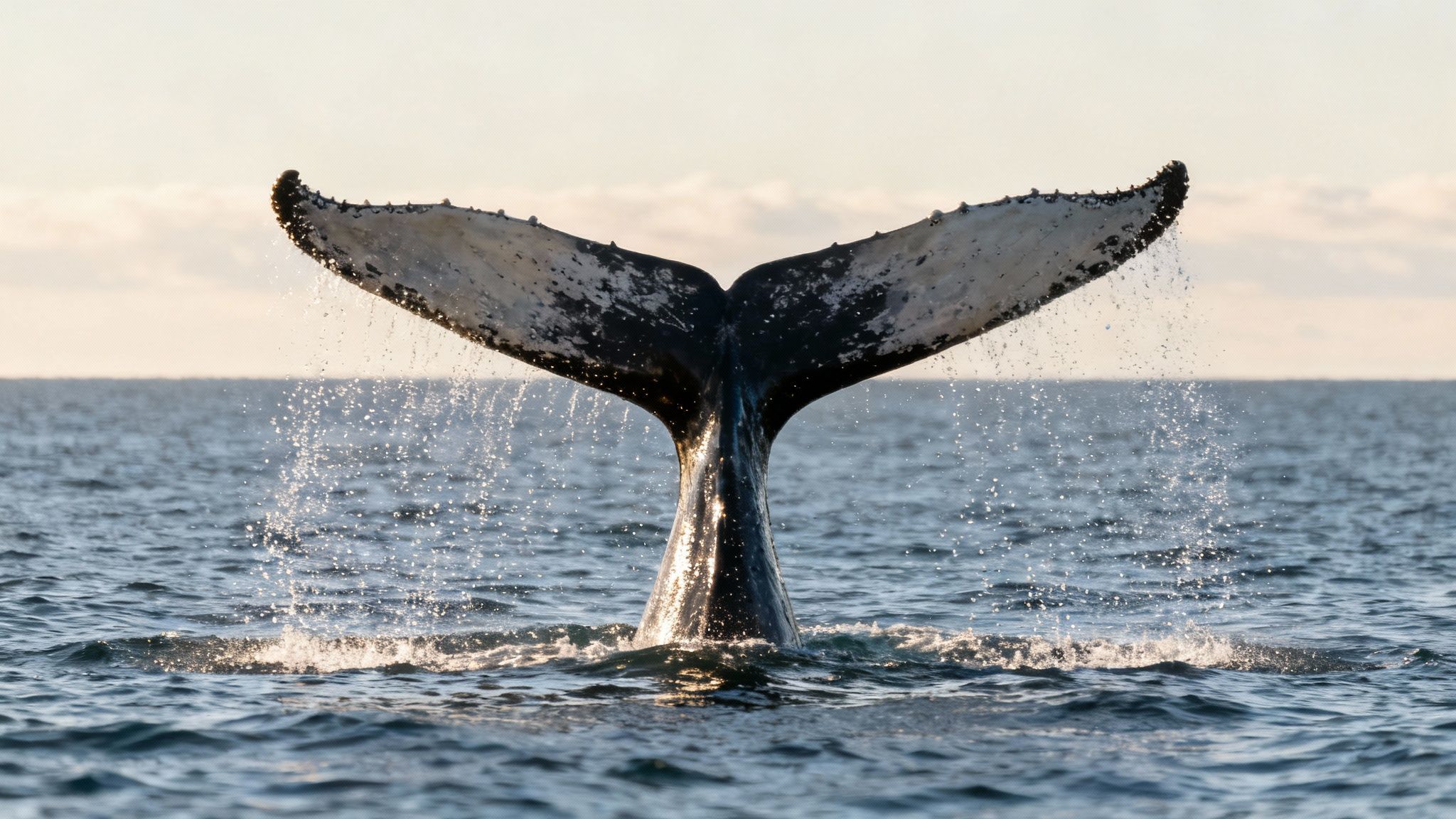
Knowing what these behaviors mean can completely transform your trip. It’s the difference between just seeing a big splash and understanding that you’ve just witnessed a profound moment of connection between these gentle giants.
The Most Awe-Inspiring Displays
While no two tours are ever the same, certain behaviors are the superstars of any whale watching Honolulu adventure. Your guides are experts at spotting and explaining what's happening, but here are a few of the most incredible displays you might get to see.
- The Breach: This is the absolute showstopper. A full-body leap where a whale weighing up to 40 tons launches itself almost entirely out of the water, crashing back down with a thunderous splash. Why do they do it? Scientists think it could be a way to communicate, shake off pesky parasites, or maybe they're just having a blast.
- Tail Slap (Lobtailing): You'll see the whale's massive tail, or fluke, lift high out of the water before smacking down with incredible force. That slap creates a huge sound that travels for miles underwater—a definite way to get another whale's attention or signal some agitation.
- Pectoral Fin Slap: A whale slapping one of its long pectoral fins on the surface is a similar sight, but it's often seen as a more social gesture, especially when groups of whales are hanging out together.
- Spy Hop: This one is just pure curiosity. The whale will lift its head straight out of the water, almost like a periscope, to get a good look around. It really feels like they're just as interested in us as we are in them.
These aren't just random movements. They're purposeful actions that are critical to everything from courtship rituals to mothers teaching their calves.
The Importance of Respectful Viewing
Seeing these behaviors up close is an absolute privilege, and with that comes the shared responsibility to protect the whales. Federal and state laws are in place to make sure these magnificent animals are not disturbed, especially during their sensitive breeding and calving season right here in Hawaii.
Regulations strictly prohibit approaching a humpback whale within 100 yards (about the length of a football field). This rule applies to everyone and everything—boats, swimmers, and drones. This buffer zone is crucial for preventing stress on the animals, particularly for moms with their vulnerable newborns.
This is exactly why choosing a professional tour operator is so important. An experienced captain and crew know these rules inside and out. They are masters at positioning the boat for amazing views without ever crowding or chasing the whales. They aim for a natural encounter, letting the whales call the shots and approach the boat on their own terms if they feel curious.
This ethical approach ensures a safe and unforgettable day for you, and more importantly, it helps protect these incredible animals for generations to come.
Choosing Your Ideal Whale Watching Tour
Not all whale watching tours are cut from the same cloth, and picking the right one really boils down to your group’s vibe and what you’re hoping to get out of the day. With plenty of options leaving from the super-convenient Kewalo Basin Harbor right near Waikiki, finding your perfect match is the key to an amazing ocean adventure.
Think of it like choosing a restaurant—are you after a lively family diner, a quiet café, or something a bit more exclusive? Each has a totally different feel. A whale watching Honolulu tour is the same way; you can find one that fits your crew perfectly, making sure everyone from toddlers to grandparents has a blast.
As the top-rated and most-reviewed snorkel company on Oahu, we at Living Ocean Tours have a whole range of guided trips designed for different kinds of travelers. This variety is all about making sure you can find an outing that clicks with your vacation goals.
Matching a Tour to Your Travel Style
Let's break down the most common types of whale watching tours you’ll find in Honolulu to make this decision a little easier. Traveling with young kids who might get antsy? A family-friendly cruise with fun extras could be just the ticket. Or maybe you're an adventurer wanting to squeeze as much as possible into your day? A tour that mixes whale watching with snorkeling might be right up your alley.
Here are a few popular options to get you started:
- Family-Friendly Cruises: These are built from the ground up with kids in mind. They usually have spacious decks, onboard amenities, and sometimes awesome extras like waterslides to keep everyone entertained.
- Whale Watch & Snorkel Combos: For anyone who wants to see the giants of the deep and the colorful world below the waves, these tours are the best of both worlds. You’ll spend some time looking for humpbacks and another part of the trip exploring beautiful coral reefs.
- Private Charters: If you're celebrating something special or just want a more personal experience, a private charter gives you total freedom. You can build your own itinerary and enjoy the ocean with just your group.
I know, weighing the options can feel like a lot. Our guide on how to choose the best boat tours in Honolulu dives even deeper to help you lock in the perfect choice.
Honolulu Whale Watching Tour Options
To help you see how everything stacks up, we've put together a quick comparison of the fantastic tours we offer at Living Ocean Tours. Each boat and trip is designed to give you a unique and unforgettable adventure. This table breaks down the key features to help you find the perfect fit for your group.
| Tour Type | Best For | Key Features | Duration |
|---|---|---|---|
| Waikiki Whale Watching Tour | Pure enthusiasts and families focused solely on whale sightings. | A dedicated tour focused on finding humpbacks with expert guides. | 2 Hours |
| Deluxe Snorkel & Wildlife Cruise | Families with kids and adventure-seekers wanting variety. | Combines wildlife viewing with snorkeling, a waterslide, and water toys. | 3 Hours |
| Private Charter | Special occasions, large groups, and customized experiences. | Offers complete privacy and a flexible itinerary for up to 40 guests. | Varies |
No matter which trip you pick, our goal is always the same: a safe, respectful, and truly awe-inspiring encounter with Honolulu's incredible marine life. We believe the best tours always put the well-being of the whales first.
By seeing the clear differences between each tour, you can confidently book the adventure that perfectly matches your vision for a day of whale watching in Honolulu. Whether it’s a focused hunt for spectacular breaches or a fun-filled day of ocean play, your ideal trip is waiting.
Preparing for Your Day on the Water
A little prep work can be the difference between a good whale watching tour and an unforgettable one. Seriously, getting a few small details right before you head out means you can just relax and focus on the incredible sight of humpback whales in their natural playground. This quick checklist will get you ready for a perfect day at sea.
Your comfort really starts with what you wear. Even on a balmy Hawaiian day, the breeze can pick up and feel chilly once the boat gets moving. Dressing in layers is always the way to go. Think a t-shirt, a long-sleeved shirt or light jacket, and comfortable shorts or pants—that way, you can easily adjust as the conditions change.
And maybe most importantly, choose your footwear carefully. Boat decks get wet and can be slippery. Non-slip shoes with a solid grip are a must for staying safe while you move around. Boat shoes, sneakers, or even secure sandals will do the trick.
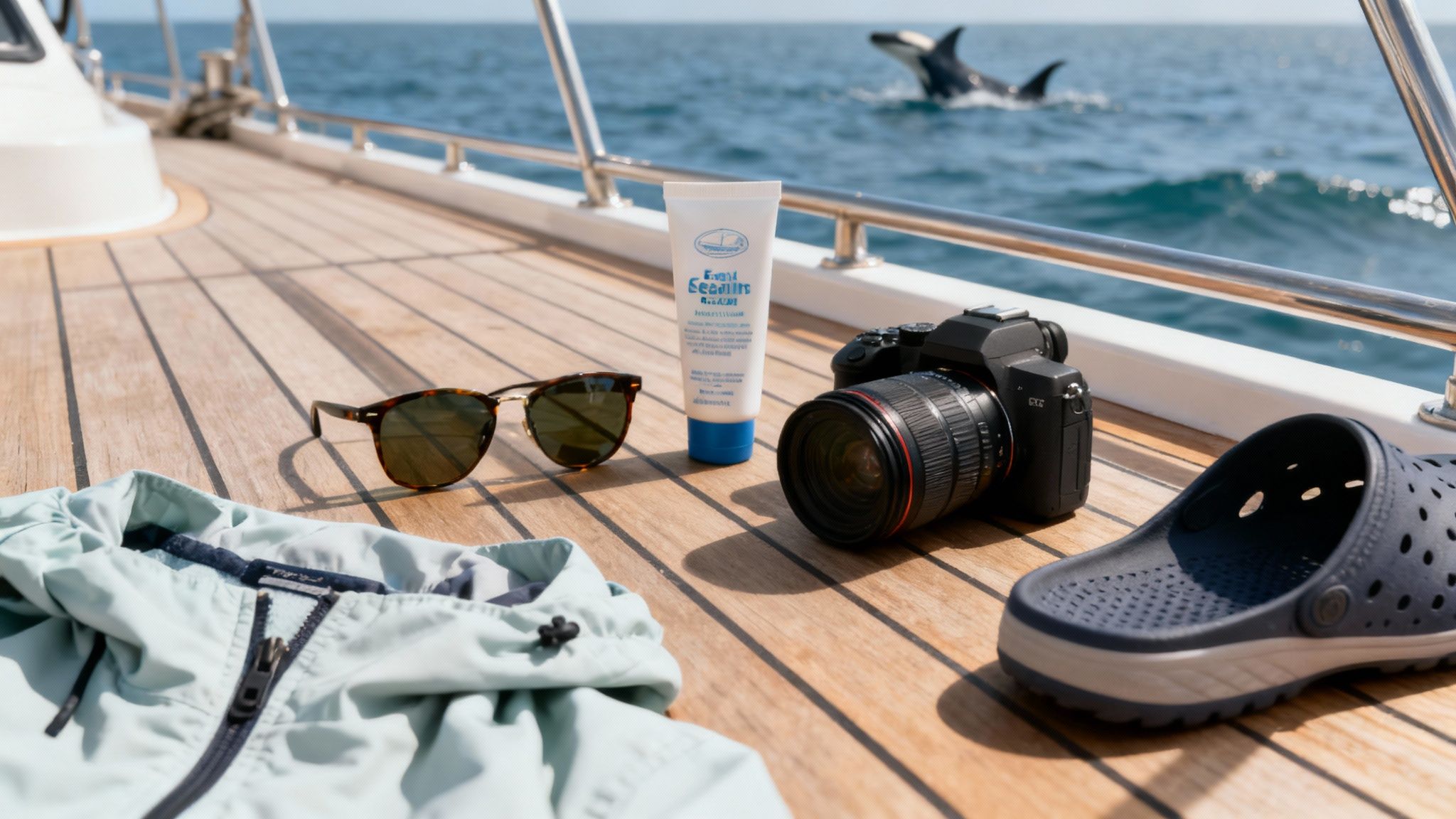
Your Essential Packing List
Tossing a few key items into a small bag can make a world of difference. You really don’t need to bring much, but the right gear is crucial for staying comfortable and getting the most out of your day. Think sun protection, good visibility, and capturing those amazing moments.
Here’s a quick rundown of what I always bring:
- Reef-Safe Sunscreen: The Hawaiian sun is no joke. Protect your skin and our fragile coral reefs by grabbing a mineral-based sunscreen that’s free of oxybenzone and octinoxate.
- Polarized Sunglasses: These are an absolute game-changer. They cut right through the glare on the water, making it so much easier to spot a whale spout or the dark shape of a whale just below the surface.
- Camera with a Zoom Lens: Your phone is great for selfies, but a real camera with a decent zoom will let you capture those breathtaking, detailed shots of the whales from a respectful distance.
- Hat and Light Cover-Up: A wide-brimmed hat is your best friend for keeping the sun off your face and neck.
These simple items will have you ready for whatever the ocean throws at you. If you’re planning on more water activities, our guide on beginner snorkeling in Oahu has some more great tips for having fun in the water.
Tips for Preventing Seasickness
Nothing ruins the excitement of a whale watch faster than feeling queasy. If you know you're prone to motion sickness—or even if you’re not sure—it pays to be proactive. That way, you can focus on the experience, not your stomach.
The secret is to prepare before you even start to feel off. Once seasickness kicks in, it's a lot tougher to shake. A few easy steps beforehand can keep you feeling great for the whole tour.
You can try over-the-counter remedies like Dramamine or Bonine, but make sure to take them an hour or two before you board, as directed. For a more natural approach, a lot of people swear by ginger chews or acupressure wristbands. Once you're on the boat, your best bet is to stay on deck where you can get fresh air and keep your eyes fixed on the stable horizon line.
It’s amazing to think about the sheer number of whales out there. Citizen science projects like the Sanctuary Ocean Count help track these gentle giants, and in March 2025, volunteers spotted an incredible 714 humpback whales across the islands. By getting yourself prepared for your tour, you can fully appreciate being part of this incredible natural event.
Exploring Honolulu's Marine Ecosystem
Sure, the humpback whales are the headliners—the reason you're out on the water in the winter. But they are far from the only stars in Honolulu's vibrant marine theater. Think of your whale watching Honolulu adventure as a full-immersion ocean safari, where any moment could bring a new and exciting wildlife encounter. The Pacific off Waikiki is absolutely teeming with life, and you've got a front-row seat.
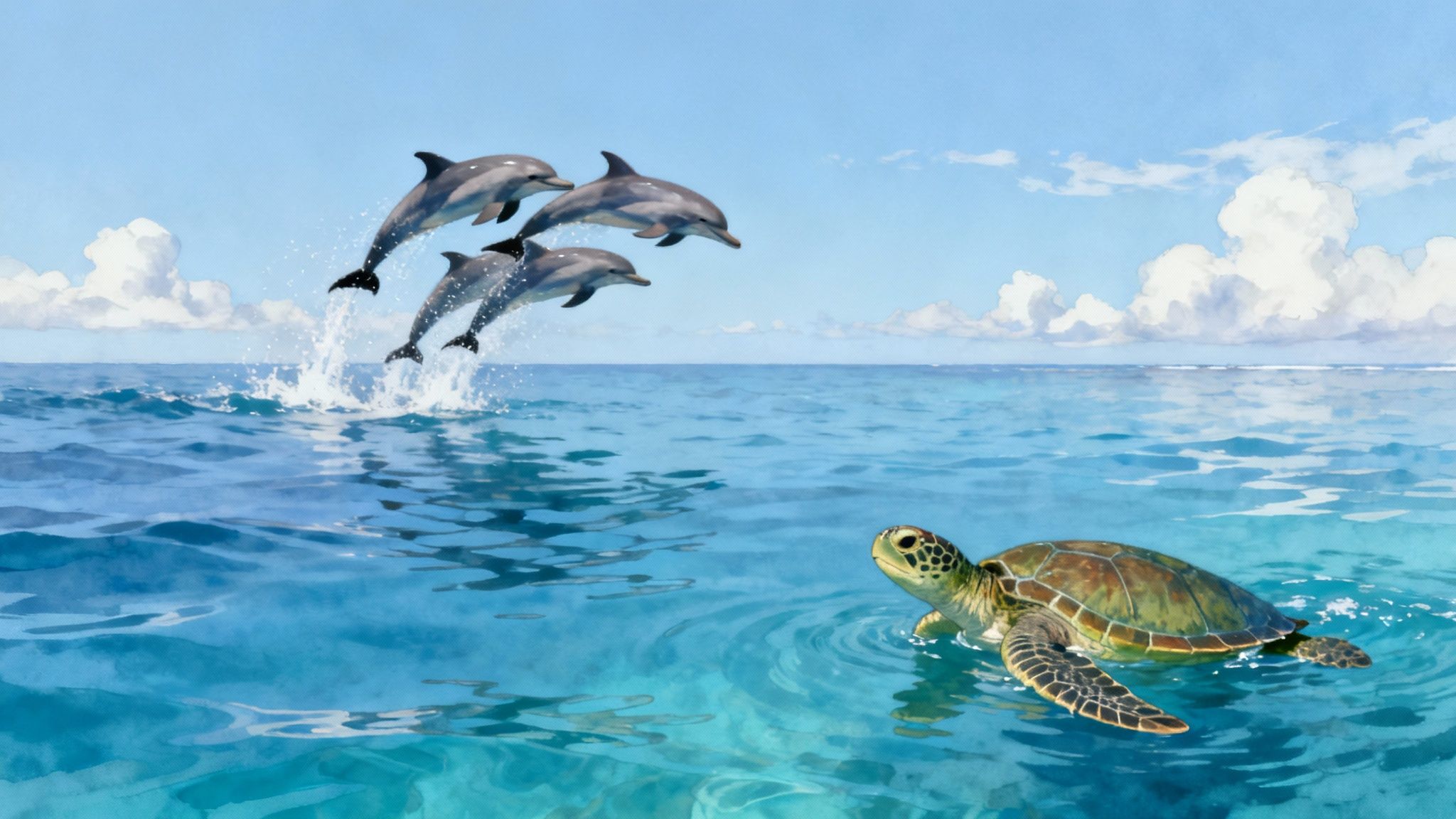
While you're scanning the horizon for the tell-tale spout of a whale, keep a sharp eye out for the other locals. The supporting cast is just as captivating, turning a simple boat trip into a deep dive into the richness of Hawaiian waters.
Beyond the Humpbacks: A Diverse Cast of Characters
One of the most common and delightful sightings is a pod of playful spinner dolphins. You’ll know them when you see them. Famed for their incredible acrobatics, these dolphins often race right alongside the boat, leaping and twisting through the air in a display that never fails to bring a smile to your face. It's pure, high-energy joy.
Another beloved local is the Hawaiian green sea turtle, or honu. In Hawaiian culture, these serene reptiles are a symbol of good luck and longevity. It’s pretty common to spot them gliding gracefully near the surface as they come up for a breath, their ancient, gentle presence adding a real touch of tranquility to the day.
An experienced tour guide does more than just drive the boat; they’re your interpreter for the ocean. They know how to spot these animals from a distance and can share fascinating insights into their behavior, diet, and their role in the local ecosystem.
The Full Ocean Safari Experience
Your whale watch is a chance to see the complete picture of life in the Pacific. While less common, other encounters can add an extra layer of excitement to your tour. Depending on the day and a little bit of luck, you might also see:
- Pilot Whales: These smaller, toothed whales are year-round residents. They're known for their social nature and their distinctive bulbous heads.
- Flying Fish: Watch the water’s surface closely. These remarkable fish launch themselves out of the sea, gliding impressive distances on their wing-like fins to escape predators.
- Seabirds: Don't forget to look up! You can spot a variety of seabirds, like the Laysan albatross and brown booby, as they hunt for fish.
Every trip out here offers a unique glimpse into this dynamic underwater world. You really get a sense of how interconnected everything is, from the smallest fish to the largest whale. To get a better feel for the incredible variety you might see, you can learn more about underwater Hawaii marine life and what makes these waters so special. It transforms your tour from just a whale watch into a genuine appreciation for the entire marine ecosystem that calls Honolulu home.
Still Have Questions? Your Honolulu Whale Watching FAQs Answered
Got a few last-minute questions before you book? I get it. Planning the perfect day on the water means getting all the details sorted. Here are the most common things people ask about whale watching in Honolulu, answered simply and clearly.
Is a Whale Sighting Guaranteed on Every Tour?
While the chances of seeing whales in Honolulu during the season are incredibly high, it’s good to remember we’re dealing with wild animals. Their behavior is never totally predictable, and that’s part of the magic.
Our experienced crews know these waters like the back of their hands and have a knack for finding the best spots. But no tour company can honestly offer a 100% guarantee—the thrill is in the search! That's what makes the moment you finally spot a whale so unforgettable.
Are the Tours Suitable for Young Children?
Absolutely. Most whale watching trips are very family-friendly and make for an amazing real-life science lesson. The boats are safe, the fresh air is great, and the excitement of seeing a giant whale is something a kid will never forget.
A good tip for parents is to pick a shorter tour if you have little ones. Also, bringing some snacks, drinks, and maybe a small activity can help keep them happy and engaged between sightings. Just be sure to check with your tour provider for any specific age restrictions.
What Is the Best Time of Day for a Tour?
Honestly, whales are active all day long, so there really isn’t a single "best" time to go. It mostly boils down to what works best for you and your family.
- Morning Tours: The ocean is often calmer in the morning, which is a huge plus if anyone in your group is worried about seasickness.
- Afternoon Tours: This is when you get that beautiful golden Hawaiian light, which makes for absolutely stunning photos of the whales against the Oʻahu coastline.
Ultimately, you can't go wrong either way. The whales will be out there!
How Far Do the Boats Go to See Whales?
It really depends on where the whales are hanging out that day. Humpbacks tend to prefer the shallower coastal waters just off Honolulu, so we usually don’t have to venture too far.
Tours typically stay within a few miles of the coast, which means you’ll always have a gorgeous view of Oʻahu’s famous landmarks. Our captains use their local knowledge and real-time updates to head straight for the areas with the most whale activity, giving you the best shot at an incredible encounter.
Ready to create some memories that will last a lifetime? Living Ocean Tours offers the premier Waikiki Whale Watching Tour to get you up close with these magnificent giants. Book your adventure today!

